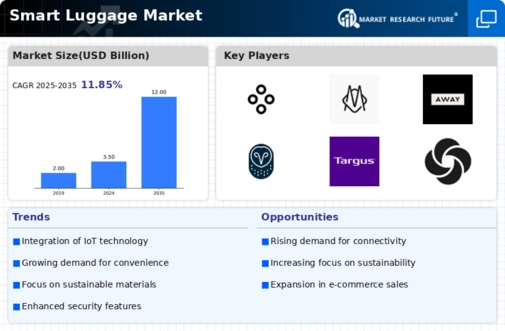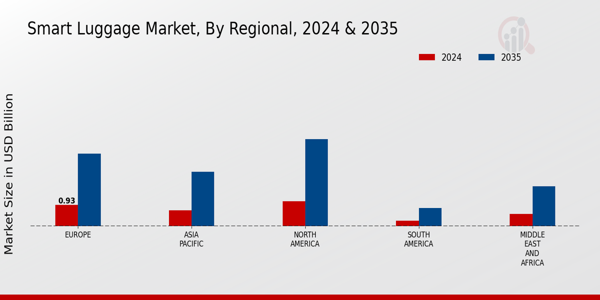E-commerce Growth
The rise of e-commerce is reshaping the Global Smart Luggage Market Industry by providing consumers with greater access to a variety of smart luggage options. Online platforms enable consumers to compare products, read reviews, and make informed purchasing decisions from the comfort of their homes. This shift towards online shopping is particularly relevant in the luggage sector, where consumers are increasingly seeking convenience and efficiency. As e-commerce continues to grow, it is expected to facilitate the expansion of the smart luggage market, making it easier for consumers to find and purchase innovative luggage solutions that meet their travel needs.
Sustainability Trends
Sustainability is becoming a pivotal factor in consumer purchasing decisions, influencing the Global Smart Luggage Market Industry. As environmental concerns grow, manufacturers are increasingly focusing on eco-friendly materials and production processes. Smart luggage brands that emphasize sustainability are likely to attract environmentally conscious consumers, thereby enhancing their market position. This trend aligns with broader shifts in consumer behavior, where sustainable practices are prioritized. The integration of sustainable practices in smart luggage production could potentially lead to increased market share, as consumers seek products that reflect their values while still offering advanced technological features.
Rising Travel Industry
The Global Smart Luggage Market Industry is closely linked to the growth of the travel sector. As international travel continues to expand, driven by increasing disposable incomes and a growing middle class, the demand for smart luggage is expected to rise. Travelers are increasingly seeking products that offer convenience and efficiency, which smart luggage provides through features like weight sensors and mobile app connectivity. This trend is expected to contribute to the market's growth, with projections indicating it could reach 12 USD Billion by 2035. The correlation between travel growth and smart luggage adoption suggests a promising future for the industry.
Market Growth Projections
Technological Advancements
The Global Smart Luggage Market Industry is experiencing a surge in demand due to rapid technological advancements. Innovations such as GPS tracking, built-in charging ports, and biometric locks are becoming standard features in smart luggage. These technologies not only enhance user convenience but also improve security, which is increasingly prioritized by travelers. As a result, the market is projected to reach 3.5 USD Billion in 2024, with a significant portion of consumers willing to invest in these high-tech solutions. The integration of such features is likely to drive growth, as consumers seek luggage that aligns with their tech-savvy lifestyles.
Consumer Awareness and Preferences
Consumer awareness regarding the benefits of smart luggage is on the rise, significantly impacting the Global Smart Luggage Market Industry. As travelers become more informed about the advantages of features such as remote locking and tracking capabilities, their preferences are shifting towards smart luggage options. This growing awareness is likely to drive sales, as consumers prioritize safety and convenience in their travel experiences. The market is projected to grow at a CAGR of 11.85% from 2025 to 2035, indicating that as awareness increases, so too will the demand for innovative luggage solutions that cater to modern travel needs.









